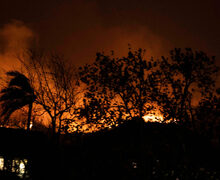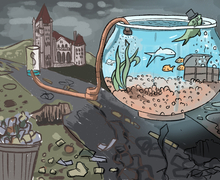What Syracuse’s mayoral candidates think about I-81, SU’s role in the city
Elizabeth Billman | Senior Staff Photographer
Many see the upcoming demolition of the Interstate 81 viaduct as an opportunity to right generations-old wrongs in Syracuse’s communities.
Get the latest Syracuse news delivered right to your inbox.
Subscribe to our newsletter here.
Neighborhood development has been a major issue both in the mayoral race this year and in past city-wide campaigns.
Many see the upcoming demolition of the Interstate 81 viaduct as an opportunity to right generations-old wrongs in Syracuse’s communities. The Daily Orange spoke with the five Syracuse mayoral candidates to gauge their thoughts on the future of Syracuse communities.
Future of the I-81 viaduct
Several politicians and city institutions have endorsed the community grid I-81 replacement plan. The grid would replace the viaduct that cuts through the city with a shop-lined boulevard, rerouting through traffic and encouraging the growth of local neighborhoods, most notably the Southside. State and federal officials approved the plan, which received $800 million in funding from the 2021 New York State budget. The first phase of construction is set to begin in 2022.
How do you plan to help the community grid plan better connect Syracuse’s neighborhoods?
Thomas Babilon (R):
“What the city really can do is make determinations as to what kind of development is going to pop up in the space that’s left in the absence of the I-81 overpass. When that disappears, there’s going to be some commercial space that opens up.”
Khalid Bey (D):
“I’ve been involved with this project since before the legislature, the council and the county were briefed on and in discussions on 81, maybe four years prior to becoming a public discussion. As a person who grew up adjacent to that viaduct, I’m more intimately aware of its impact. I have respiratory issues that I’ll never get rid of because of breathing in … leaded gasoline.”
“The key thing is assuring that the city gains ownership and control over the property, and along with that, making sure that we do the right type of development there. It should be standard when we do any further development in the city to assure that people with moderate means can live and shop wherever they want.”
Janet Burman (R):
“I’m optimistic about what can come out of (the community grid). Blueprint 15, which is the major redo of public housing in the city, should help with that. I’m hoping that the availability of that housing will coincide with the completion of the community grid so there will be more connected opportunities for employment closer to where the housing is.”
Michael Greene (D):
“My proposal is to have a community land trust. There’s about 18 acres of land that would be left over from the highway, and we would give it to an entity that would be controlled by the community. And what we’d be doing is building affordable housing and businesses. That’d be a good step in trying to bring back some of that vibrancy.”
Ben Walsh (I):
“(I-81) divided our city and also accelerated suburban sprawl. It created an expedited way for people to get out of the city. We have an opportunity to right some of those wrongs. We can begin to knit back together the fabric of the city and of our neighborhoods, and to make sure that when we’re building our neighborhoods back, we’re building them better.”
Syracuse University’s role in the city
Over half of land in Syracuse is tax exempt, with SU being the largest of those landowners in the city. Between SU, SUNY-ESF, multiple area hospitals and others, 51% of land in the city does not collect tax, totalling over $3.8 billion in property value, as of 2011.
What do you think SU’s role should be in the city, and how do you plan on working with and bettering the relationship with the university?
Thomas Babilon (R):
“The university provides a great service to the city. It puts the city on the map. People travel to the city to attend events at SU (which) increases the sales tax revenue for the city. I think that the city and the university have to have a good relationship.”
Khalid Bey (D):
“Our biggest struggle — and I won’t just put it on Syracuse University but any large nonprofit — is the challenge to shore up our tax base. A big part of our handicap is the fact that Syracuse University and Upstate Medical Center and others who don’t pay taxes are our largest property owners. The shared services agreement that the university has had with this mayor and the previous mayor is a step in the right direction. We would hope that other nonprofits would see that and use that as an example”
Janet Burman (R):
“We have the problem of this huge surge of very attractive housing for affluent students and high vacancy rates of those multi-family houses that were occupied by students. So to the extent that university can help smooth that transition and help the Eastside neighborhoods in converting back to a more residential environment that would really make a big difference I think.”
Michael Greene (D):
“When you think about what the future of Syracuse could be, we can be a great university town in a way that a lot of larger cities like Columbus and Austin. I think (Syracuse is) smaller, but they’re defined by the cultural amenities that come out of those universities. You have these great museums, these great musical scenes, all these things that trail off the success of the cultural thought leaders coming from the universities.”
“There’s always going to be a need to have a strong relationship. Just the athletic program is a point of pride for a lot of local residents. So to the extent that there’s additional areas where the city can collaborate with the university and take advantage of all that brain power and energy on the hill, we need to do that.”
Ben Walsh (I):
“We view Syracuse University as a part of this community. They’re not two separate communities. This city would be completely different without Syracuse University and our other educational and medical institutions. So we see the leadership of the university as critical partners. Syracuse University cannot be truly successful in the long term if they’re not located in a vibrant, growing city, and Syracuse can’t be a vibrant, growing city without a strong university anchoring the city, so based on that mutual acknowledgement we’ve been able to work closely together.”
Published on May 3, 2021 at 10:17 pm
Contact Nick: nickrobertson@dailyorange.com | @NickRobertsonSU






